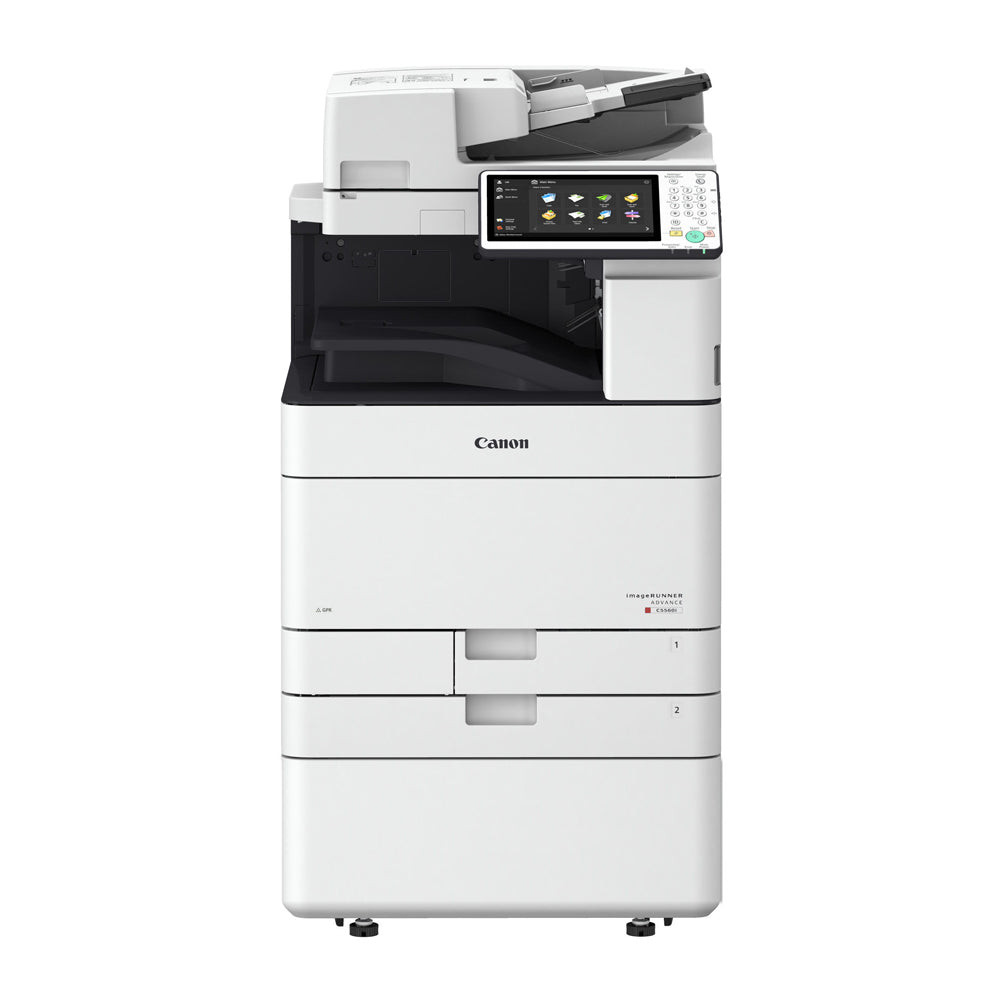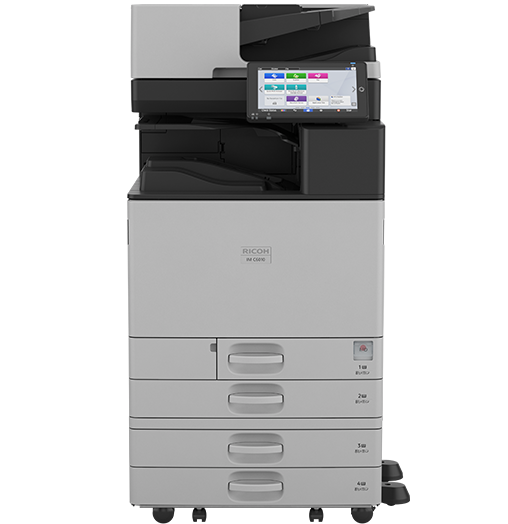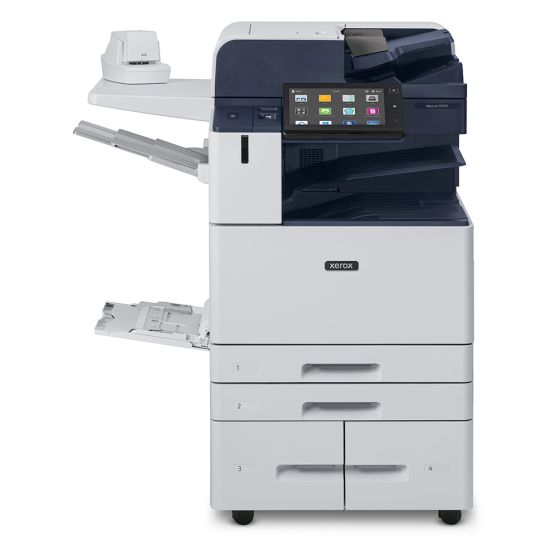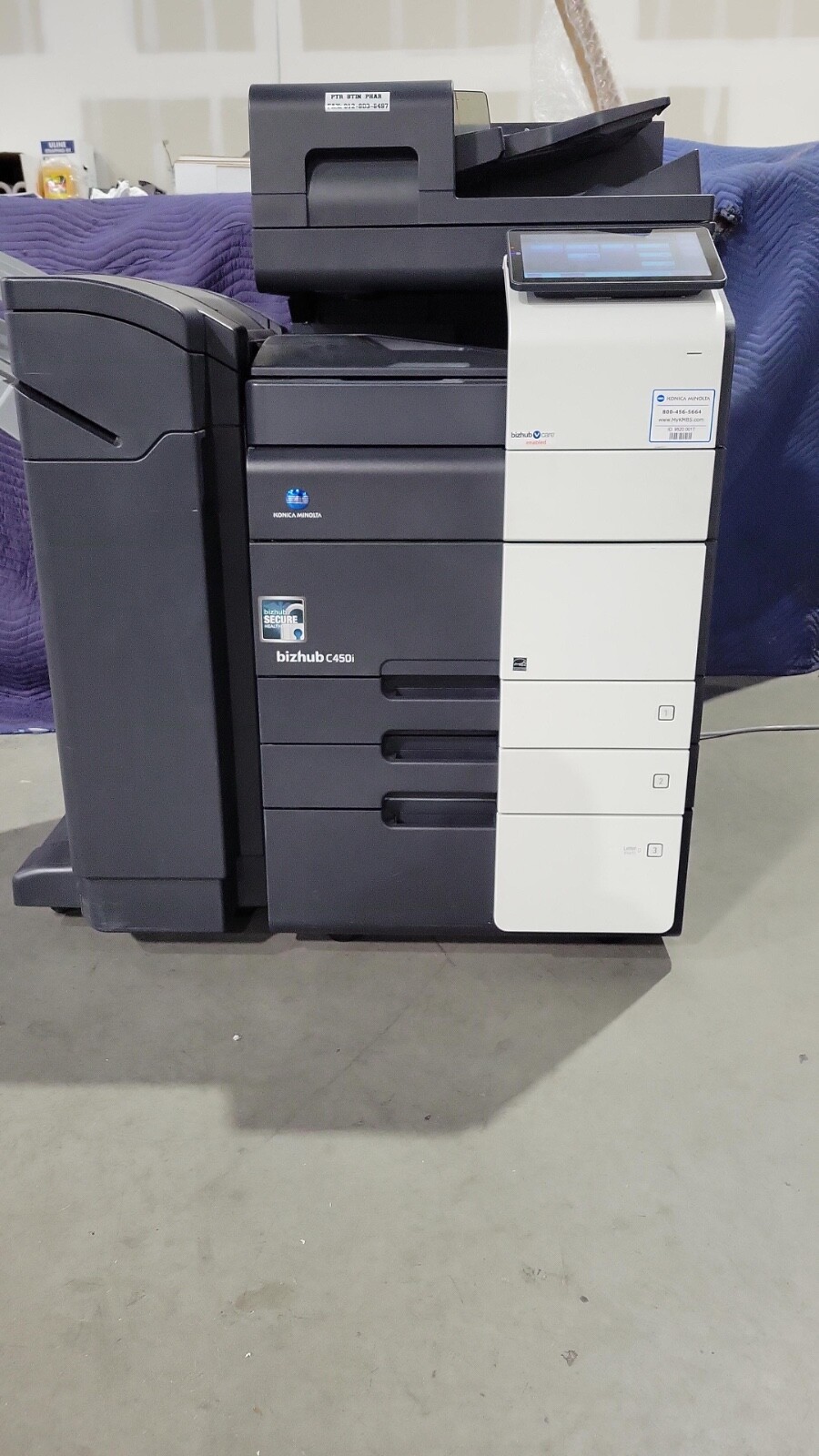Industry Overview
The healthcare industry faces unique document management challenges that demand specialized copier and printer solutions. With the increasing digitization of medical records, strict HIPAA compliance requirements, and the need for seamless integration with Electronic Medical Record (EMR) and Electronic Health Record (EHR) systems, healthcare providers need document solutions that go far beyond basic printing capabilities. Modern healthcare copiers must protect sensitive patient information at every touchpoint, from scanning lab results to printing prescriptions, while maintaining the speed and reliability required in fast-paced medical environments. Whether you operate a small private practice, a multi-specialty clinic, or a large hospital system, the right copier solution can dramatically improve patient care workflows, reduce compliance risks, and lower operational costs. Healthcare organizations typically process thousands of pages daily—from patient intake forms and insurance documentation to medical charts and billing statements—making equipment selection a critical business decision. The best healthcare copiers offer end-to-end encryption, secure print release requiring user authentication, automatic audit trail logging, and direct integration with popular EMR platforms like Epic, Cerner, and Allscripts. These features not only ensure HIPAA compliance but also streamline clinical workflows, allowing medical staff to focus on patient care rather than wrestling with technology. Additionally, healthcare copiers must support mobile printing for doctors and nurses using tablets, accommodate high-volume scanning for medical records digitization, and provide reliable performance during peak periods.
Healthcare Industry Challenges
Understanding the unique challenges you face
Patient Data Security
Protecting sensitive patient information (PHI) from unauthorized access and breaches while maintaining HIPAA compliance.
Integration Complexity
Seamlessly connecting copier systems with existing EMR/EHR platforms and hospital information systems.
High-Volume Requirements
Managing large volumes of medical records, insurance forms, and patient documentation efficiently.
Our Solutions for Healthcare
Specialized features designed for your industry's specific needs
Enhanced Security
End-to-end encryption, secure print release, and user authentication protect patient data at every touchpoint.
Streamlined Workflows
Direct integration with EMR systems reduces manual data entry and speeds up patient care processes.
Compliance Confidence
Built-in HIPAA compliance features including audit trails, access controls, and automatic data wiping.
Key Features & Capabilities
Everything you need to meet industry requirements
Recommended for Healthcare
These models are specifically selected for their features, reliability, and compliance with healthcare requirements
Common Use Cases
See how our solutions work in real-world scenarios
Patient Record Management
Securely print, scan, and manage patient medical records with encrypted transmission to EMR systems.
Prescription Printing
Controlled access prescription printing with user authentication and audit trails for compliance.
Insurance Documentation
High-volume processing of insurance claims, EOBs, and billing statements with OCR capabilities.
Lab Results Distribution
Secure print-and-release for lab results ensuring only authorized staff can access sensitive information.
Compliance & Standards
Meeting all regulatory requirements for your industry
Detailed Compliance Requirements
Understanding the specific regulations that impact your document workflows
HIPAA Privacy and Security Rules
The Health Insurance Portability and Accountability Act (HIPAA) establishes strict requirements for protecting patient health information. All copier and printer systems handling Protected Health Information (PHI) must implement administrative, physical, and technical safeguards.
- End-to-end encryption for all data transmission and storage
- User authentication before print job release (pull printing)
- Automatic data overwriting after each job to prevent data remanence
- Comprehensive audit logs tracking all document access and printing activity
- Business Associate Agreements (BAAs) with equipment vendors
- Regular risk assessments and security updates
HITECH Act Requirements
The HITECH Act strengthens HIPAA enforcement and adds specific requirements for electronic health records. Healthcare organizations must ensure their document management systems support meaningful use requirements and breach notification obligations.
- Breach notification protocols for unauthorized PHI access
- Enhanced penalties for HIPAA violations
- Support for electronic health record (EHR) incentive programs
- Accounting of disclosures for electronic PHI
- Enhanced patient rights for electronic records
Document Retention Requirements
Healthcare providers must maintain medical records for specific periods as mandated by federal and state laws. Document management systems should support compliant retention and destruction policies.
- Adult medical records: Minimum 6 years from last treatment (varies by state)
- Minor medical records: Until age of majority plus statute of limitations
- Medicare/Medicaid records: Minimum 5 years
- Employee health records: Duration of employment plus 30 years for exposure records
- Imaging and diagnostic reports: 5-10 years depending on state law
- Prescription records: Minimum 2 years (DEA requirement for controlled substances)
Common Document Workflows
Streamlined processes designed for healthcare operations
Patient Intake and Registration
The patient registration process involves collecting, scanning, and routing multiple documents to appropriate systems while maintaining HIPAA compliance.
Scan patient intake forms, insurance cards, and identification documents
OCR technology extracts data automatically to reduce manual entry errors
Documents route directly to EMR system with proper patient matching
Secure storage with access controls limits viewing to authorized personnel
Original documents shredded using HIPAA-compliant destruction methods
Lab Results and Diagnostic Imaging
Healthcare facilities process high volumes of lab results and imaging reports that must be securely distributed to physicians and integrated into patient records.
Lab results received electronically or via fax to secure server
Automated routing to ordering physician and patient chart
Secure print release ensures results only printed when physician authenticates
Critical results flagged for immediate attention via alert systems
Results automatically archived in EMR with proper indexing
Audit trail records all access to sensitive diagnostic information
Prescription Management
Prescription printing requires the highest level of security to prevent fraud and ensure patient safety while meeting DEA and state pharmacy board requirements.
E-prescribing integration with pharmacy networks reduces errors
Secure prescription printing with tamper-resistant paper for controlled substances
User authentication required before prescription printing
Automatic logging of all prescription print jobs for audit purposes
Integration with state Prescription Drug Monitoring Programs (PDMPs)
Void/reprint capabilities with full audit trail
Top Copier Models for Healthcare
Our expert-recommended equipment specifically suited for your industry
Canon imageRUNNER ADVANCE C5560i
$12,000 - $18,000This enterprise-class MFP offers comprehensive HIPAA compliance features including user authentication, automatic data overwriting, and seamless EMR integration. Its reliability makes it ideal for hospital departments and large clinics processing thousands of pages daily.
Key Features:
- MEAP platform enables custom healthcare applications and EMR connections
- Secure Print with card authentication ensures patient data protection
- High-speed scanning at 270 ipm perfect for medical records digitization
- Department ID tracking for accurate cost allocation
- McAfee embedded security prevents malware attacks
Ricoh IM C6010
$10,500 - $15,000Ricoh's Smart Integration platform provides excellent connectivity to Epic, Cerner, and other major EMR systems. The IM C6010 balances performance with security, making it suitable for medium to large medical practices.
Key Features:
- Smart Integration platform connects to 400+ business applications
- Workflow automation reduces repetitive tasks for medical staff
- Advanced security features meet HIPAA technical safeguards
- Cloud connectivity for mobile printing from tablets and smartphones
- Exceptional uptime and reliability for mission-critical environments
Xerox AltaLink C8170
$11,000 - $16,500The AltaLink C8170 excels at high-volume scanning and offers robust security features essential for healthcare. Its ConnectKey technology provides app-based customization for healthcare-specific workflows.
Key Features:
- ConnectKey apps customize workflows for healthcare processes
- Automatic redaction capabilities protect patient privacy
- Highest level security certification (Common Criteria)
- VersaLink integration with healthcare IT systems
- Superior image quality for medical imaging and diagnostic reports
Konica Minolta bizhub C450i
$8,500 - $12,000This mid-range model provides enterprise security features at a lower price point, making it ideal for small to medium practices. The bizhub Secure platform ensures comprehensive data protection.
Key Features:
- bizhub Secure platform prevents unauthorized data access
- HDD encryption and automatic overwrite protect patient information
- Card authentication integration for secure print release
- Compact footprint fits small exam rooms and nursing stations
- Lower cost per page reduces operational expenses
HP LaserJet Managed MFP E82550
$9,500 - $13,500HP's enterprise solution offers exceptional security with JetAdvantage Security Manager and is particularly strong for multi-location healthcare organizations needing centralized fleet management.
Key Features:
- JetAdvantage Security Manager provides centralized policy control
- Pull printing with badge readers prevents document abandonment
- Self-healing security automatically detects and repairs threats
- FutureSmart firmware regularly updated with security patches
- Excellent support for remote healthcare locations
Volume Requirements & Planning
Understanding typical usage patterns in healthcare
Monthly Volume
Healthcare facilities have widely varying print volumes depending on size and specialization. Small private practices (1-5 physicians) typically print 5,000-15,000 pages monthly, primarily patient intake forms, after-visit summaries, and prescriptions. Medium clinics and specialty practices (6-20 physicians) average 25,000-75,000 pages monthly with higher volumes in specialties like radiology and pathology that produce extensive reports. Large multi-specialty clinics and community hospitals (100-300 beds) frequently exceed 150,000 pages monthly across all departments, including administration, medical records, billing, and clinical areas. Major hospital systems and academic medical centers can process over 500,000 pages monthly when accounting for all locations and departments. Accurate volume planning should account for both routine clinical printing and administrative functions like billing, insurance verification, and medical records requests.
Peak Periods
- Monday mornings see 40-60% higher print volumes as staff process weekend admissions and prepare for the week
- Flu season (October-March) increases patient volumes and associated documentation by 25-35%
- End of month billing cycles generate significant volume for patient statements and insurance claims
- Open enrollment periods (typically November) create spikes in insurance verification documents
- Medical records audit seasons require high-volume printing of compliance documentation
- New patient orientation periods at academic medical centers increase printing of educational materials
Growth Planning
When selecting copier equipment, healthcare organizations should plan for 20-30% growth capacity to accommodate practice expansion, regulatory changes requiring additional documentation, and transition to value-based care models that increase reporting requirements. Consider scalability features like additional paper trays, finishers, and the ability to upgrade to higher-speed engines. Multi-location practices should implement fleet management systems that provide visibility into usage across all sites. Additionally, factor in the transition toward electronic workflows—while paper usage may decrease for some documents, other areas like patient education materials and regulatory compliance documentation continue to grow. Equipment should support both current paper-based processes and future hybrid digital-paper workflows to maximize return on investment.
Security Considerations
Protecting sensitive information in healthcare environments
Data-at-Rest Protection
Healthcare copiers store document images temporarily on internal hard drives, creating a significant security risk if not properly managed. Modern healthcare-grade MFPs must include hard drive encryption (AES 256-bit), automatic data overwriting after each job, and the ability to securely erase the drive before equipment disposal or return at lease end. Many data breaches occur when copiers are returned without proper hard drive sanitization, potentially exposing thousands of patient records.
Network Security and Access Controls
Copiers connected to hospital networks require the same security measures as other network devices. Implement network segmentation to isolate copiers on separate VLANs, disable unnecessary network protocols, and use SNMPv3 instead of older insecure versions. User authentication should integrate with Active Directory or LDAP systems to enforce single sign-on and centralized access control. Role-based access restricts sensitive functions like faxing patient records or accessing the address book to authorized personnel only.
Secure Print Release and Pull Printing
Pull printing (also called secure print release or follow-me printing) requires users to authenticate at the copier before documents print, preventing confidential patient information from sitting in output trays. Implementation typically uses proximity cards, PIN codes, or biometric authentication. This feature alone can reduce HIPAA breaches related to document abandonment by over 90% while providing the added benefit of reducing waste from uncollected print jobs.
Audit Logging and Compliance Monitoring
Comprehensive audit trails tracking who printed, scanned, or copied what documents and when are essential for HIPAA compliance and incident investigation. Healthcare organizations should implement log management systems that centrally collect and analyze copier audit data, alert security teams to suspicious activity, and provide reports for compliance audits. Logs should be retained according to organizational policies (typically 6-7 years) and protected from tampering or deletion.
Success Stories
Real-world results from healthcare organizations
Regional Hospital System Achieves Full HIPAA Compliance
450-bed regional hospital system with 12 outpatient clinics
Challenge
The hospital system faced recurring HIPAA violations due to documents left in printer output trays, inconsistent equipment security policies across locations, and inability to track document access for audit purposes. They needed a comprehensive solution across 89 copiers and printers in 13 locations.
Solution
Implemented Canon imageRUNNER ADVANCE fleet with uniFLOW secure print release requiring badge authentication at all devices. Deployed centralized security policy management, automatic hard drive encryption and overwriting, and integration with Epic EMR for direct scanning to patient charts. Added mobile printing solution for physicians using tablets.
Results
- Zero HIPAA violations related to document security in 24 months following implementation
- Reduced print volume by 32% due to elimination of unclaimed print jobs
- Saved $47,000 annually in paper and toner costs
- Improved physician satisfaction scores by 18% due to mobile printing capabilities
- Reduced time spent on medical records requests from 45 minutes to 12 minutes per request
- Passed Joint Commission audit with zero document security findings
Multi-Specialty Clinic Streamlines Patient Intake Process
18-physician multi-specialty clinic with 140 staff members
Challenge
Patient check-in process created bottlenecks with manual data entry from paper forms into EMR, averaging 8-12 minutes per patient. Insurance verification delays caused appointment backups, and staff spent excessive time filing and retrieving paper documents from storage.
Solution
Deployed Ricoh IM C6010 MFPs at each reception station with custom workflows that scan patient documents directly into Allscripts EMR with automatic patient matching. Implemented OCR technology to extract data from insurance cards and driver licenses, auto-populating demographic fields. Added secure fax server for electronic insurance verification.
Results
- Reduced patient check-in time from 10 minutes to 3 minutes average
- Eliminated 2.5 FTE positions previously dedicated to filing and document retrieval
- Improved insurance verification accuracy from 87% to 98%
- Reduced claims denials due to eligibility issues by 64%
- ROI achieved in 14 months through labor savings and improved revenue cycle
- Patient satisfaction scores increased 23% due to reduced wait times
Frequently Asked Questions
Common questions about copiers for healthcare
What makes a copier HIPAA compliant?
A HIPAA-compliant copier must include technical safeguards such as data encryption (both in transit and at rest), user authentication, automatic data overwriting, and comprehensive audit logging. The device should support secure print release to prevent document abandonment, integrate with your network security infrastructure, and allow for secure disposal of the hard drive at end of service. Additionally, you must have a Business Associate Agreement (BAA) with the vendor. No copier is inherently "HIPAA compliant" – compliance requires proper configuration, policies, and vendor agreements.
Do I need secure print release at every device?
Yes, HIPAA's Security Rule requires covered entities to implement procedures to safeguard patient information. Secure print release (pull printing) is one of the most effective ways to prevent unauthorized access to printed PHI. Even in areas with restricted access, documents can be viewed by unauthorized personnel if left in output trays. The minimal inconvenience of authenticating before retrieving print jobs is far outweighed by the risk of a HIPAA breach, which can result in fines starting at $100-$50,000 per violation with annual maximums of $1.5 million per violation category.
Can healthcare copiers integrate with our EMR system?
Yes, modern healthcare MFPs can integrate with all major EMR/EHR systems including Epic, Cerner, Allscripts, athenahealth, eClinicalWorks, and NextGen. Integration typically happens through TWAIN scanning drivers, HL7 interfaces, or manufacturer-specific platforms like Canon's MEAP, Ricoh's Smart Integration, or Xerox's ConnectKey. The level of integration varies from basic "scan to EMR" functionality to advanced features like automatic patient matching, barcode recognition for chart identification, and bidirectional communication. Work with both your EMR vendor and copier dealer to ensure compatibility and proper implementation.
What should happen to copier hard drives when we return leased equipment?
Before returning any leased copier or disposing of owned equipment, the internal hard drive must be securely erased using DoD 5220.22-M standards (minimum 7-pass overwrite) or physically destroyed. Simply deleting files or formatting the drive is insufficient – forensic tools can easily recover data. Request a certificate of data destruction from your dealer. Many healthcare organizations choose to purchase and retain hard drives when returning leased equipment rather than risk data exposure. This is a common HIPAA breach vector that receives regulatory scrutiny.
How do we track copier usage for HIPAA audit purposes?
Modern healthcare copiers generate detailed audit logs that can track user identity, job type (print/copy/scan/fax), time/date stamp, page count, and sometimes document names. These logs should be automatically forwarded to a centralized log management system or SIEM (Security Information and Event Management) platform. Many copier management solutions like uniFLOW, PaperCut, or YSoft SafeQ provide healthcare-specific reporting and can alert administrators to unusual patterns. Logs should be retained for 6-7 years to align with typical medical record retention requirements and be readily available for compliance audits or breach investigations.
What's the difference between cost per page for color vs. black and white in healthcare?
Healthcare organizations typically pay $0.008-$0.015 per page for black and white printing and $0.06-$0.12 per page for color, depending on equipment, volume, and service contract terms. Medical imaging, diagnostic reports, and patient education materials often require color printing, but many healthcare documents (prescriptions, forms, charts) work fine in black and white. Implementing print policies that default to black and white unless color is necessary can save 40-60% on printing costs. Advanced solutions can enforce color printing restrictions based on document type or user role.
Can we print prescriptions for controlled substances from our copier?
Yes, but with specific requirements. Prescriptions for Schedule II controlled substances must use tamper-resistant paper when printed, as mandated by the Medicare Modernization Act. The paper must include features that prevent copying, erasure/modification, and use of counterfeit forms. Many healthcare organizations are transitioning to electronic prescribing (e-prescribing) for controlled substances, which eliminates paper requirements but requires EPCS (Electronic Prescribing of Controlled Substances) certification and two-factor authentication. Your copier should integrate with your e-prescribing system and support secure printing of backup paper prescriptions when required.
How often should healthcare copiers receive security updates?
Healthcare copiers should receive firmware and security updates at least quarterly, or immediately when critical vulnerabilities are discovered. Major manufacturers release security patches regularly – Canon, Ricoh, Xerox, and Konica Minolta all publish security bulletins. Your service contract should include automatic notification of security updates and remote deployment when possible. Include copier firmware updates in your organization's vulnerability management program and test updates in a non-production environment before deploying fleet-wide. Outdated firmware is a common finding in healthcare IT security audits.
What is the typical service response time for healthcare copiers?
Healthcare organizations should negotiate service level agreements (SLAs) that reflect the criticality of document systems to patient care. Standard SLAs offer next-business-day response, but hospitals and time-sensitive clinics should require 4-hour response times for critical devices. Some organizations maintain backup devices in high-priority locations. Premium service contracts may include preventive maintenance visits, automatic toner replenishment, and dedicated support representatives familiar with your environment. For mission-critical applications like emergency department patient tracking or surgical scheduling, consider redundant devices or contractual guarantees of same-day loaner equipment if primary devices fail.
Should we lease or buy healthcare copiers?
Most healthcare organizations lease copiers because leasing provides predictable monthly costs, includes maintenance and supplies, ensures equipment stays current with technology and security updates, and avoids large capital expenditures. Lease terms typically run 36-60 months with options to upgrade to newer equipment. However, high-volume organizations with strong IT capabilities might benefit from purchasing equipment and negotiating separate service contracts, potentially saving 15-25% over the equipment lifecycle. The decision should factor in your organization's cash flow, tax situation, IT capabilities, and how quickly healthcare technology evolves. Leasing provides more flexibility as EMR integration requirements and security standards continue to evolving.
Industry Resources
Helpful guides and tools for healthcare professionals




